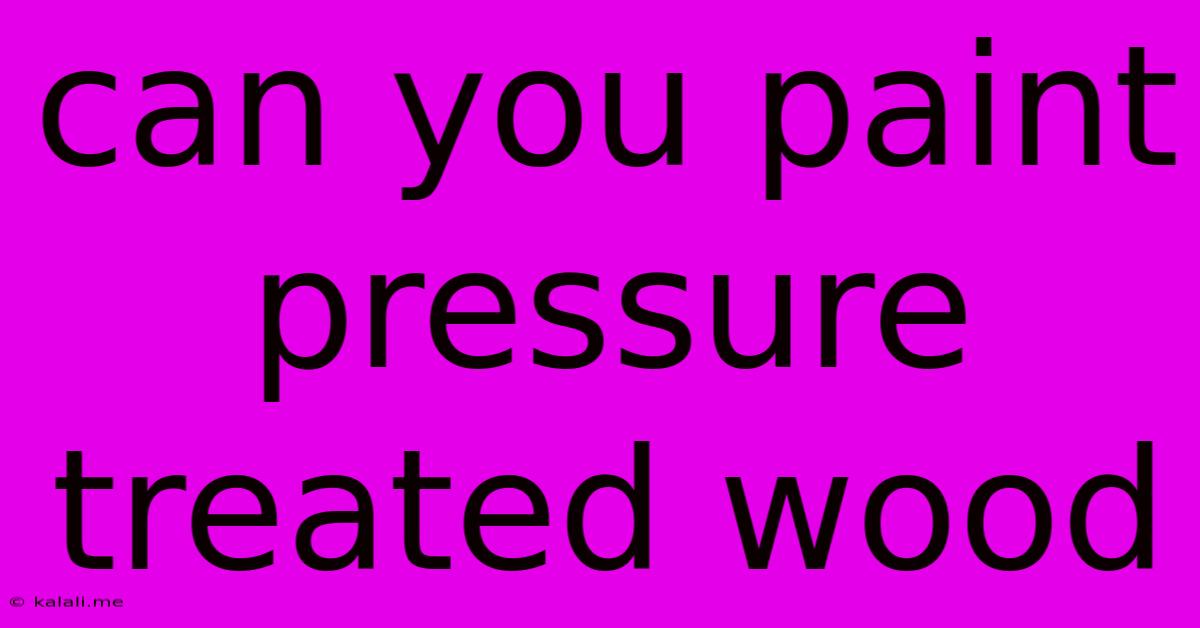Can You Paint Pressure Treated Wood
Kalali
May 23, 2025 · 3 min read

Table of Contents
Can You Paint Pressure Treated Wood? A Comprehensive Guide
Pressure-treated wood is a popular choice for outdoor projects due to its durability and resistance to rot and insects. But can you paint it? The short answer is yes, but it's not as simple as painting regular wood. This guide will cover everything you need to know about painting pressure-treated lumber, from preparation to the best types of paint to use. Understanding this process will help ensure a long-lasting, beautiful finish for your project.
Understanding the Challenges of Painting Pressure Treated Wood
Pressure-treated wood contains chemicals designed to protect it from the elements. These chemicals can leach out over time, affecting the adhesion of paint. This leaching process, coupled with the wood's inherent dryness, can lead to paint peeling, cracking, and premature failure. Therefore, proper preparation is key to success. Choosing the right paint is also crucial for achieving a durable finish that withstands the weather.
Preparing Pressure-Treated Wood for Painting
Preparation is the most critical step in painting pressure-treated wood. Skipping this stage will almost certainly result in poor adhesion and a short-lived paint job. Here's a detailed breakdown of the process:
-
Allow Sufficient Curing Time: This is arguably the most important step. Newly treated wood needs time for the chemicals to dissipate. The recommended curing time varies depending on the type of treatment and the manufacturer's instructions, but generally, it's at least 3-6 months, and sometimes even longer, especially in warmer climates. Waiting longer is always better than rushing the process.
-
Clean the Wood Thoroughly: Remove any dirt, debris, mildew, or loose wood fibers using a stiff-bristled brush, pressure washer (low pressure), or a combination of both. A thorough cleaning ensures optimal paint adhesion.
-
Sanding (Optional but Recommended): While not always necessary, lightly sanding the surface will create a smoother texture and improve paint adhesion. Use a fine-grit sandpaper (120-150 grit) to avoid damaging the wood.
-
Prime the Wood (Highly Recommended): This step is essential for ensuring proper paint adhesion. Use a high-quality primer specifically designed for exterior use and pressure-treated wood. This primer will help seal the wood and prevent the chemicals from interfering with the paint. Consider using an oil-based primer for better penetration and sealing.
Choosing the Right Paint for Pressure-Treated Wood
Not all paints are created equal. For pressure-treated wood, you need a paint that is durable, weather-resistant, and specifically formulated for exterior use. Here are some options:
-
Acrylic Latex Paint: This is a popular choice due to its ease of application, durability, and low odor. Look for a high-quality acrylic latex paint designed for exterior use and rated for good adhesion.
-
Oil-Based Paint: Oil-based paints offer superior durability and water resistance, but they have a stronger odor and require mineral spirits for cleanup. They can offer a longer-lasting finish but are generally less environmentally friendly than water-based options.
-
Specialty Paints for Pressure-Treated Wood: Some manufacturers produce paints specifically formulated for pressure-treated lumber. These paints often contain additives that enhance adhesion and provide extra protection against moisture and UV damage.
Painting Techniques for Best Results
Once the wood is properly prepared and primed, follow these painting tips for a professional-looking finish:
-
Apply Thin Coats: Multiple thin coats are better than one thick coat. This allows the paint to dry properly and prevents sagging or running.
-
Use a High-Quality Brush or Roller: Investing in good quality tools will make the process smoother and result in a more even finish.
-
Allow Sufficient Drying Time Between Coats: Follow the manufacturer's instructions for drying time between coats.
By following these steps, you can successfully paint your pressure-treated wood and enjoy a beautiful, long-lasting finish. Remember that patience and thorough preparation are key to a successful project. Don't rush the process, and your efforts will be rewarded with a stunning and durable result.
Latest Posts
Latest Posts
-
Power Company Meter Sets Taxed By City
May 23, 2025
-
Three Way Switch With Dimmer Wiring
May 23, 2025
-
Does Tv Infrared Receiver See Room
May 23, 2025
-
Canat Use Fill Tool In Gim
May 23, 2025
-
Blender Render Using Vpu Even After Preferences
May 23, 2025
Related Post
Thank you for visiting our website which covers about Can You Paint Pressure Treated Wood . We hope the information provided has been useful to you. Feel free to contact us if you have any questions or need further assistance. See you next time and don't miss to bookmark.